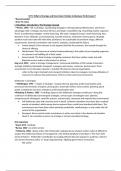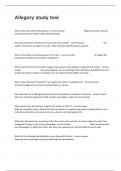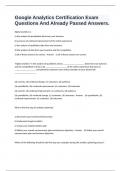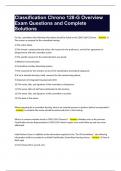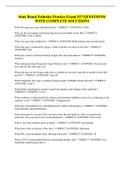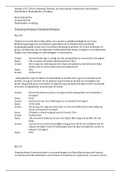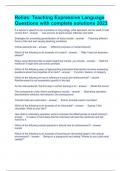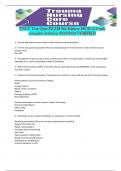*Recommended
~from Y1 notes
L1 Readings- Introduction: The Strategy Concept
*~Porter, 1996- <OE vs strategy, 3 positioning strategies> OE (operational effectiveness, short-term
advantage only) v strategy. Excessive OE focus and hyper competition (eg. US printing market, Japanese
firms). 3 positioning strategies: variety-based (eg. Jiffy Lube, Vanguard Group); needs-based (eg. Ikea,
Bessemer Trust, Citibank); access-based (eg. Carmike Cinemas, small town cinema-goers). Strategic
position must have trade-offs with other positions to be sustainable (inconsistent image, different
requirements, internal coordination and control). Example: Continental lite failure.
Variety-based: it thus chooses to not segment itself by the customer, but instead through the
choice of offering
Needs-based: The converse of variety-based positioning is the option of just targeting segments
of customers and fulfilling all of their needs
Access-based: The final strategy is targeting customers that have similar needs, but with
disparate access routes to the product or service.
Nag et al, 2007- <what is strategic management> Consensual definition of SM include 6 elements:
strategic initiatives (intended/ emergent), managers and owners, resources, performance, firms,
environment. From boundary-spanners, included 7th element internal organisation.
- refers to the major intended and emergent initiatives taken by managers involving utilisation of
resources to enhance the performance of firms in their external environments
Deliberate vs emergent
*~Whittington 1993- <4 types of strategy>: classical (formal, planning, profit maximisation aim),
processual (incremental, emergent, plural goals), systematic (follow social context, planning, plural
goals), evolutionary (survival, emergent, profit maximisation aim)
Mintzberg & Waters, 1985- <8 strategy types on the deliberate-emergent continuum> along this
continuum of deliberate and emergent strategies, various types of strategies exist: planned,
entrepreneurial, ideological, umbrella, process, unconnected, consensus and imposed (by environment)
Full Deliberate: plan with concrete level of detail. Collective intentions must have been realized
exactly as intended, which means that no external force could have interfered with them. The
environment must have been either perfectly predictable, totally benign, or else under the full
control of the organization.
Emergent: there must be order (consistency in action over time) in the absence of intention
about it. No consistency means no strategy or at least unrealized strategy.
Not important
*Grant 2019- textbook
*Barney 2002- no online version
.*McKenna, 2006- <ghost writer John McDonald> widespread use of ghost writers makes it difficult to
analyse the intellectual history of management. John McDonald ghost wrote Sloan's "My Years with
General Motors". McDonald's contribution to strategy beforeit became popular in academia, where it
was termed 'business policy' or 'long-range planning'. Applying game theory to business.
- Not useful
,*Ghemawat, 2002- <history of strategy> rise of strategy with MBEs, rise of consultants with portfolio
analysis concepts (BCG growth-share matrix, GE/McKinsey nine-block matrix). Industry attractiveness
(industrial organisation, Porter's 5 forces, value net model with complementors). Competitive position
(competitive cost analysis with cost drivers and cost sharing; customer analysis with low cost/
differentiation). Competitive dynamics (Game theory, RBV, Dynamic capabilities, commitment)
L2 Readings- How Persistent is High Performance and How can it be Explained?
Industry distribution
*Axtell 2001- < Zipf distribution of firm sizes, growth rate/ wage> Empirical study. Few large firms, more
small firms. Variance of growth rates is lower with larger firms. Larger firms pay higher wages for the
same job (wage-size effect). Firm growth rates follow a Laplace distribution (concentrated around
certain levels).
*Kohli & Sah 2006- <power law in market share & implications> empirically, market share patterns
across product categories are represented well by the power law (more extreme than exponential form,
which fits low market shares better). Implications include large investment to reach next stable market
share level, target setting at next stable level, assess performance for resource allocation decisions,
identify unstable markets for opportunity/ threat.
Caves, 1998- <growth rates, size, entrants> variance of growth rates decreases with size; stable size
distributions over time; high rates of entrant firm mortality; entrant initial size based on market
structure/ perceived capability; barriers to entry affect no. of entrants and survival rate (surv. rate is the
stronger effect)
- High mortality rate and low variance of growth in large firms suggests persistence
Firm-specific factors
*~Rumelt, 1991- <empirical firm over industry> Importance of firm-specific factors over industry factors
in determining long term profitability and economic rents. Empirical data of interindustry vs
intraindustry profit differences
8% industry effects, 1% corporate (parent company) effects, 46% business unit effects
~McGahan & Porter, 1997- <challenges Rumelt, 1991> with empirical data, industry over firm.
*Bruderl et al, 1992- <factors affecting firm survival> human capital theory (founder characteristics),
organisational ecology (org. characteristics and environment). Org. characteristics (size via employee
no., capital invested; org. strategies operating at national level) are most important for survival,
followed by human capital characteristics (founder industry experience), then environment
Bloom & Reenen 2007- <poor management practice causes and distribution> poor management
practices are more prevalent when (i) competition is weak (ii) family-owned firms pass management
control down by primogeniture. European firms face less competition and display higher levels of
primogeniture (explains why US firms managed better). Significant cross-country differences in
management quality and within-country differences, with long tail of very badly managed firms
Persistence
*Waring 1996- <industry affect persistence: sources of persistence of firm-specific returns in
industries>- persistence of firm-specific rents vary between industries depending on industry economic
structure. Key variables affecting persistence: skill (informational impediments to imitation), consumer
purchases as % of output (switching costs) (+), no. of firms (-), economies of scale (+), R&D intensity (+).
, Jacobsen 1988- <firm affect persistence: slow convergence of ROI, 3 factors lengthen period, no effect of
industry concentration> returns in terms of ROI is mean reverting but with slow convergence, allowing
for abnormal profits for some time. Managers can increase period of abnormal return via high vertical
integration, market share, and marketing expenditure intensity. Industry concentration plays no role in
persistence and profitability
Wiggins & Ruefli 2002- <low incidence/ persistence of superior performance> Empirical study. (1) while
some firms do exhibit superior economic performance, (2) only a very small minority do so, and (3) the
phenomenon very rarely persists for long time frames.
Bias/ misconceptions
*Jerker 2005- <biased data in factors leading to success, 3 traps> selection bias in data with successful
companies overindexed. Selection bias worse for established companies/ mature industries, less bad for
VCs/ emergent industries. 3 traps: overvalue risky practices, current accomplishments magnified by past
achievements (good results despite poor actions now), lack of reverse causality. Popular management
theories may be inaccurate.
*Rosenzweig 2007- <Halo effect, flawed studies, 3 misconceptions> Halo effect: tendency to make
specific inferences based on general impression. Popular studies with data not independent of
performance (In search of excellence, Built to last, Good to Great). Misconceptions: formula for success
exists (performance is relative, no single formula), performance driven by internal factors (relative
performance means external factors matter), good/poor results != good/poor decisions (risk).
Not important
.*Powell 2003- <competitive parity models and performance distribution> perfect parity, stochastic
parity, pareto parity, natural parity. Empirically, performance distributions based on industry leadership
fit pareto and natural parity better. Data consistent with idea that firm-specific advantages are local and
extreme phenomena
- Not useful
.Denrell 2003- <under sampling lead to false beliefs> under sampling of failure lead to false beliefs on
effective management (eg. that concentrated resource allocation better than diversified resource
allocation)
- Same point in Jerker 2005
Chan et al 2003- <persistence and predictability of growth rates> no persistence in long-term earnings
(not sales) growth beyond chance; low predictability of growth rates given various predictor variables
- Same point in Wiggins & Ruefli 2002
Examples
Pinterest: Variety-based positioning
o focusing on fashion, design, cooking segments of visual discovery
Walmart: Strategy of asymmetric costs
o Increase costs, but less for you than them (e.g. Walmart in favour of making employee
insurance mandatory for the industry, hurts smaller competitors more)
Walmart: location
o Locate in rural cities that can only support one major retailer (deter entry)

